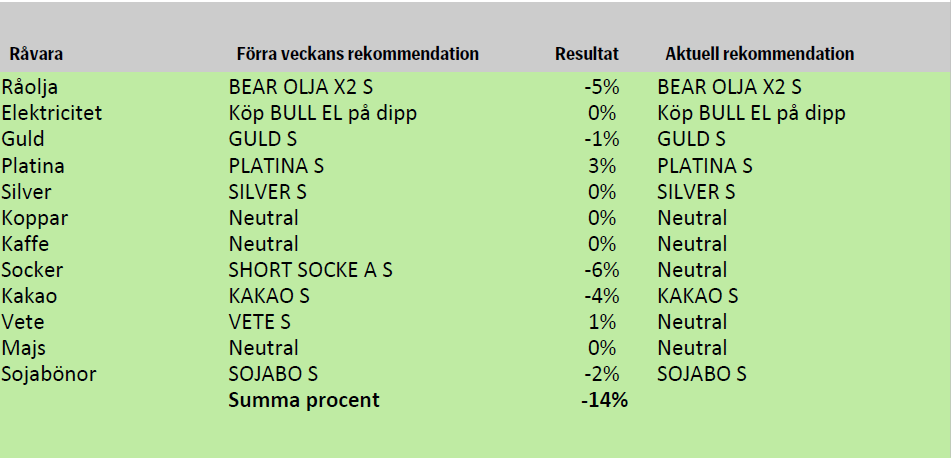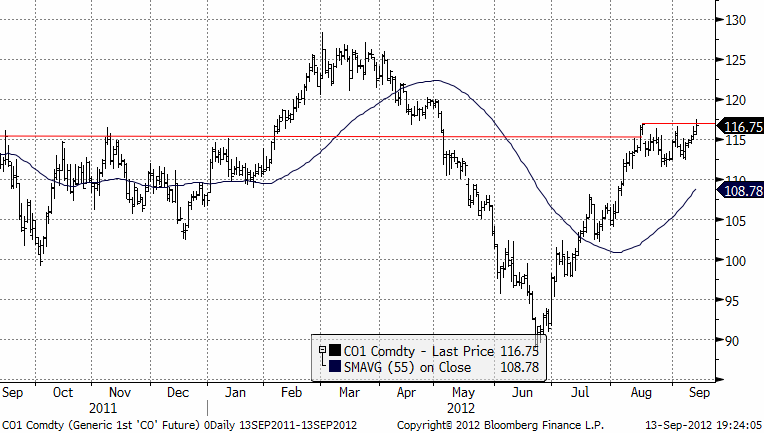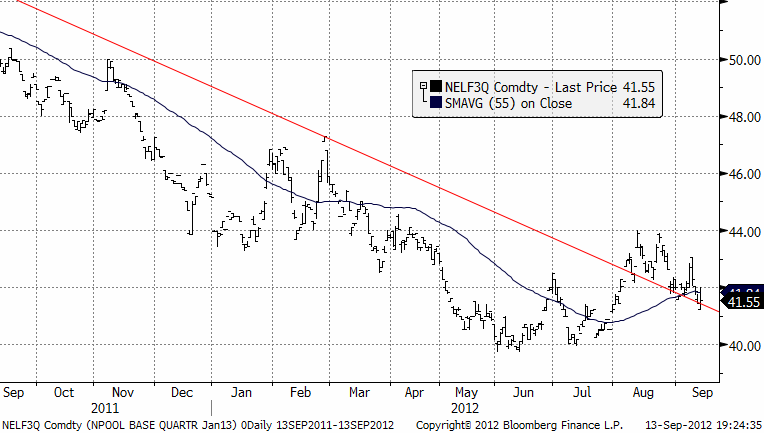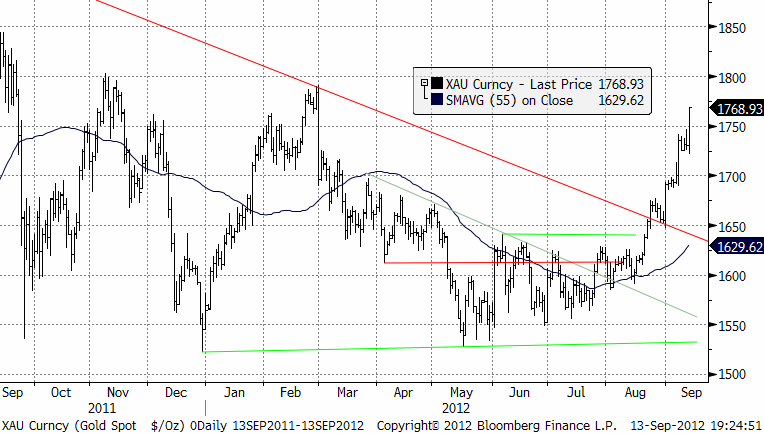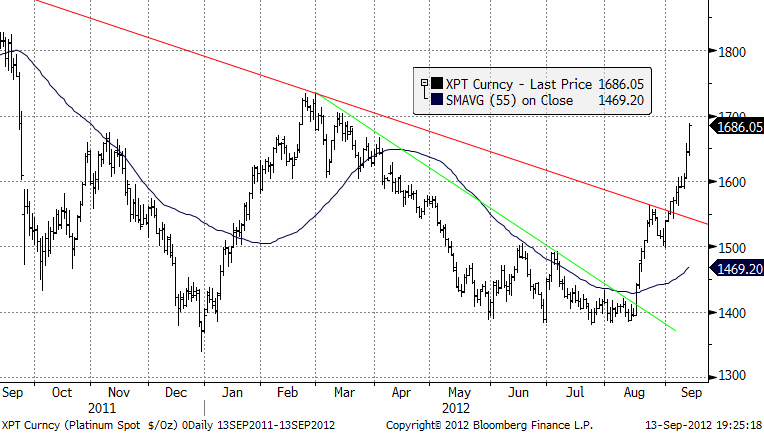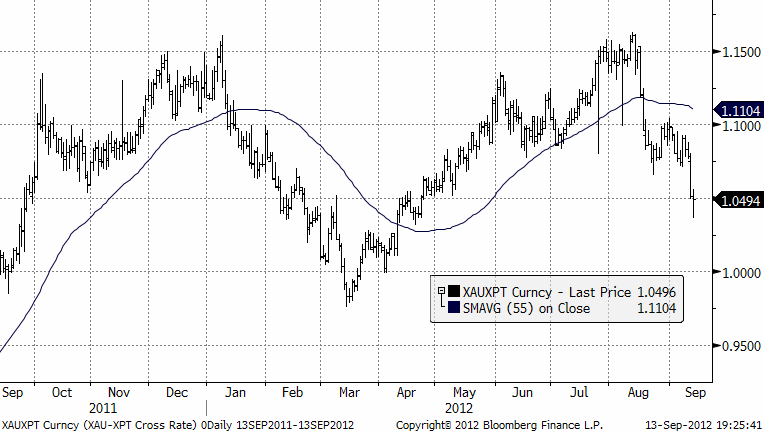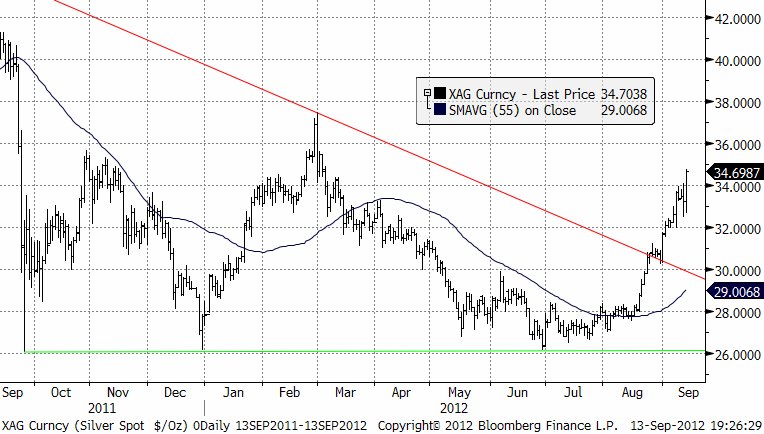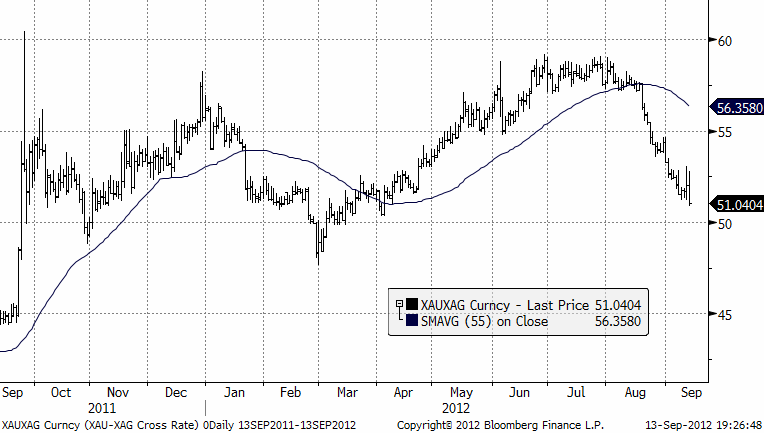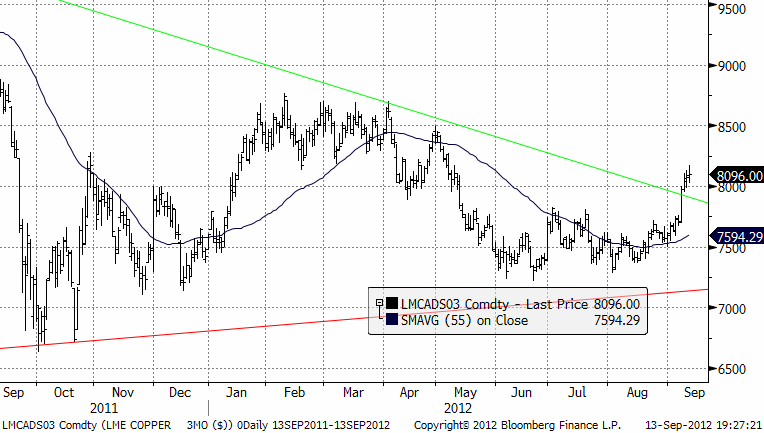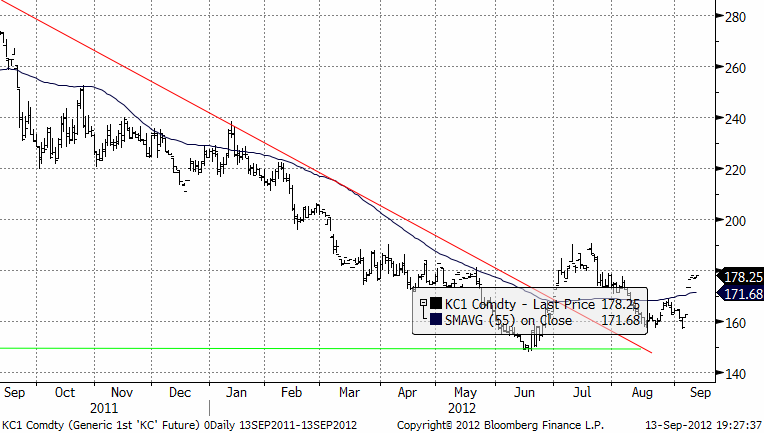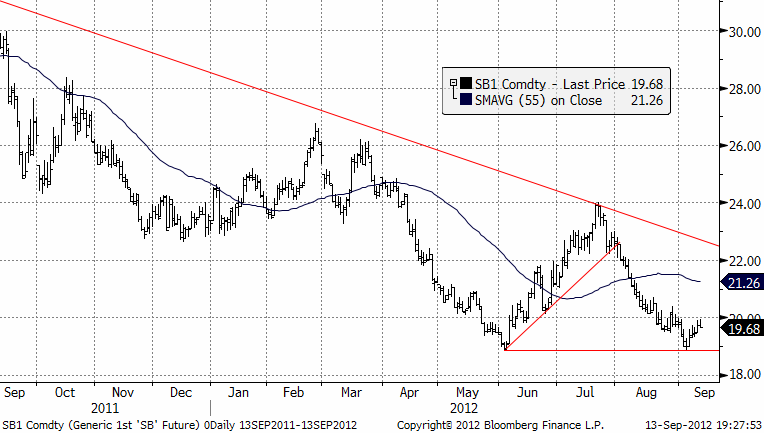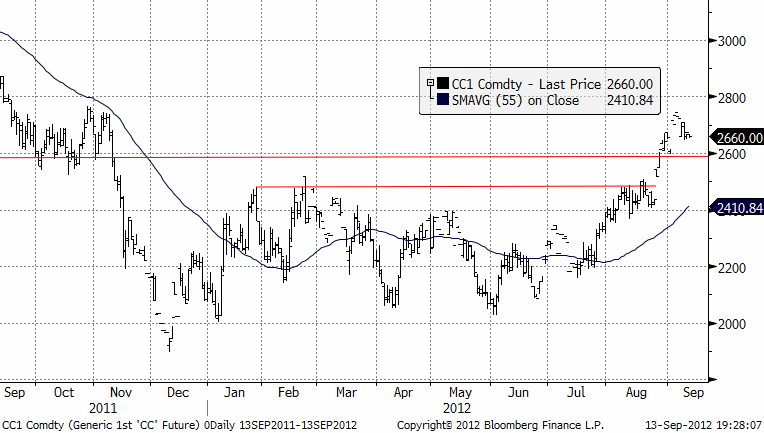Analys
SEB – Råvarukommentarer, 14 september 2012
Sammanfattning av rekommendationer
Förra veckans summerade vinst på 28% vändes den här veckan såsom mätt per stängning igår torsdag, till en förlust. Dock skulle det ha sett annorlunda ut om man beräknade vinsten idag, eftersom FED:s besked igår kväll ledde till kursrusning i ädelmetallerna. FED annonserade en öppen Quantitative Easing (QE3), där man ska köpa amerikanska bostadsobligationer för 40 miljarder dollar varje månad till dess sysselsättningen förbättras. FED fortsätter också ”Operation Twist” och behåller räntorna mellan noll och 0.25%. Man lovade att hålla räntorna i botten fram till slutet av 2014. En journalist för the New York Times beskrev den här oväntade aggressiviteten så här: ”We will provide the punch for the party. Heavy pours. And we’re not going to be too careful about closing time.”
Naturligtvis är detta mycket positivt för ädelmetaller. Men fundamentalt är efterfrågan på råvaror alltjämt svag. Det betyder att koppar, olja, elektricitet och annat som efterfrågas när industrin går på högvarv kanske omotiverat har stigit i pris. Sedelpressen skapar inte tillväxt och välstånd.
Råolja – Brent
Trots QE3 har råoljepriset svårt att gå över 117 dollar, där det finns ett tekniskt motstånd. Vi förväntar oss ett svagare oljepris in i det fjärde kvartalet, men Iran-problematiken hänger i bakgrunden som ett olöst problem. Orkansäsongen i Mexikanska golfen och underhållsarbeten på Nordsjön, tillsammans med säsongsmässigt hög konsumtion har gett stöd till oljemarknaden. QE3 och det tyska godkännande av ESM ger också stöd. Men underliggande svag makroekonomisk statistik visar att efterfrågan är svag framöver i USA, Europa och Kina. Således tror vi att oljepriset kommer att falla tillbaka något från nuvarande nivå när vi ger oss in i det fjärde kvartalet.
Oljemarknaden är emellertid i en svår situation. Balansen mellan utbud och efterfrågan är svag. Reservkapaciteten är liten, pga sanktionerna mot Iran och det finns inga tecken på ett det ”phony war” är på väg att lösas. Snarare tvärt om. Iran fortsätter arbeta på sitt kärnenergiprogram. Man kan därför lätt tänka sig en ytterligare åtstramning av sanktionerna från EU och USAs sida. Israel har än så länge låtit Kfirerna stå på marken. Strategiska lager finns att lätta på om det skulle bli ännu hårdare restriktioner. Detta skulle kunna gjuta olja på varje prisuppgång.
Vi rekommenderar en kort position i oljemarknaden, om man inte föredrar att förhålla sig neutral. Alltså t ex BEAR OLJA X2 S.
Elektricitet
Vi har noterat att de flesta varit intresserade av att köpa BULL EL X4 S, medan vi här vidhållit att det är lite för tidigt att göra det. Vi tror att priset kommer att utveckla sig svagt under september och oktober, att marknaden söker en botten under den här perioden. Ett pris under 40 euro per MWh är köpvärt. Nu är 40 euro ett tekniskt stöd, så det är möjligt att 40 euro är botten. Mellan 40 och 41 euro kan det vara köptillfälle, men annars bör man vara försiktig med BULL.
Guld, Silver och Platina
Allt har talat för ädelmetallerna den här veckan: Löften om monetära stimulanser på båda sidor om Atlanten. Tekniskt sett ser det mycket starkt ut. Guld är upp 4 %, silver och platina ca 6 % sedan förra fredagen. Vi deklarerade förra veckan att ädelmetallerna hade mer att ge. Målkurserna som vi angav börjar närma sig och det kan vara idé att börja ta hem vinster. $1800 för guld och $35 för silver utgör motståndsnivåer. Platina kan vara undantaget där potentialen kan vara större med tanke på oroligheterna i Sydafrika som har eskalerat i veckan. Uppror och strejker har spridits till fler gruvor, och flera bedömare varnar för kaos i hela landet. Det är i och för sig inte bra för utbudet på guld heller, även om Sydafrika för längesedan lämnade förstaplatsen som producentland.
Vår favorit är Platina (t ex genom certifikatet PLATINA S, eller för den som vill ha lite mer hävstång, BULL PLATIN X4 S). Nedan ser vi platinaprisets utveckling, där brottet av den långsiktiga motståndslinjen, signalerade att den långa konsolideringsperioden är bruten, på uppsidan. Det ser ut som om 1700, toppen från februiari/mars, kan bli ett motstånd. Det är sent i den raska uppgångsfasen och det är väl inte otroligt att det kommer lite eftertankens kranka blekhet här. Med vägen stadigt inslagen på helikopterpengar i världe borde dock priset på ädelmetaller som t ex platina kunna inflateras mer.
Nedan ser vi priset på guld dividerat med priset på platina. Vi ser att guld har utvecklats sämre än platina sedan mitten av augusti. Tekniskt ser den här trenden stark ut och har potential att gå från 1.05 till 1, dvs en outperformance på ytterligare 5% till platinas fördel. Det mesta av rörelsen från 1.15 är dock avklarad och platina har inte lång tid kvar att vara vår favorit bland ädelmetallerna.
Nedan ser vi silverprisets kursutveckling. Det är samma starka tekniska köpsignal i den här metallen.
Även i den här jämförelsen med silver, ser vi att guld har utvecklats sämre än silver sedan månadsskiftet juli/augusti. Vi ser att det finns en stödnivå kring 50 i kvot mellan guld och silverpris. Silverprisets uppgång i förhållande till guld är nära den nivå och vi rör oss alltså in i stödområdet. Det mesta av silvrets outperformance i förhållande till guld är avklarat.
Koppar
Förra veckans svaga arbetsmarknadsstatistik blev (paradoxalt nog) startskottet för ett nytt rally för både bas- och ädelmetaller. Det var en ”tillräckligt” svag siffra som skulle behövas för att få FED att agera. Helgens nyhet att Kina beslutat om ett infrastrukturpaket inkluderande järnvägs- och tunnelbanebyggen motsvarande 157 Mdr USD, blev nästa impuls. Förväntningarna var således högt ställda, och FED:s besked nu ikväll (torsdag) om ett nytt penningpolitiskt stimulanspaket, har därför ännu inte gett någon större effekt. Prisuppgångarna sedan förra fredagen ligger mellan 5 och 10 % för de stora basmetallerna. Aluminium sticker ut med en uppgång på hela 10 %.
I skrivandes stund ligger kopparpriset på LME kring $8180 ($3,72/Lbs) vilket är upp ca 5 % från förra fredagen. Marknaden har nu (med besked) brutit igenom motståndet. Stimulanspaketen från Kina, Europa och USA har naturligtvis gjort sitt för att stärka stämningsläget. Frågan är hur det ser ut fundamentalt. Det bör påpekas att Kina som förbrukar ca 40 % av all koppar befinner sig i en avmattning. Det gäller att stimulanserna får effekt för att prisnivåerna ska hålla. Det är svårbedömt. Aktörerna räknar med fler åtgärder från den kinesiska ledningen. Frågan är till vilka sektorer stimulanserna riktas. Utbyggnaden av elnätet betyder mest (för koppar). Lagernivåerna är höga, vissa marknadsbedömare uppskattar den totala nivån till hela 1,8 milj. ton (det produceras ca 18-19 milj. ton globalt). Statistiken i Kina är osäker. Om det stämmer är det väldigt stora lager, men kom ihåg att Kina kommer att behöva metallen förr eller senare. Just nu är mycket av ett positivt scenario inprisat. Risken har ökat för en rekyl.
Vi väljer att vara neutrala till koppar till nästa veckobrev.
Kaffe
Priset på Arabica, som handlas i New York, som steg pga regnen i viktiga kaffeodlingsormråden i Brasilien i juni och juli, föll sedan tillbaka i augusti.
Colombia, som är världens näst största producent av arabica, tycks vara på väg mot en mindre skörd än väntat. Colombia behöver skörda 3.6 miljoner säckar (à 60 kg) från och med nu till årsskiftet, eller 34% mer än samma period förra året, för att nå upp till 8.5 miljoner säckar. Det är vad Colombias ”National Federation of Coffee Growers” förutspådde den 10 september.
Tekniskt verkar priset röra sig ”sidledes” och vi avvaktar ett eventuellt köp lite längre fram.
Socker
Priset på socker, tycks ha funnit ett stöd. Priset vände upp på samma nivå som i juni. Det skulle inte förvåna om priset nu steg upp mot motståndslinjen, dvs till 21 – 22 cent per pund, ur teknisk synvinkel.
Regnväder har återvänt till Brasiliens sockerrörsproducerande områden. Somar Meteorologia i Sao Paulo kommenterar att fälten kan vara för blöta för att skörda mot slutet av oktober. Branschföreningen Unica rapporterar produktionsdata varannan vecka. I Sud-Oeste (Center South i engelsk betydelse), där delstaten Sao Paulo ligger, hade branschen processat 9.4% mindre sockerrör än förra året fram till slutet av augusti. Augusti låg dock högre än förra året, då man tog igen vad man missat tidigare. Augusti låg 14.2% över förra årets augusti. Risken är nu alltså att regnen åter gör det svårt att skörda, vilket bör ge stöd för priset på socker.
I Indien, världens näst största producent av socker, har monsunen, som står för 70% av nederbörden i landet, fortsatt att förbättras. Från att under sommaren ha legat ca 30% sämre, ligger nederbörden sedan den 1 juni nu bara 9% under genomsnittet för de senaste 50 åren.
Vi stänger positionen i SHORT SOCKE A S. Och så ser vi vad som händer, om det kan utveckla sig ett köptillfälle istället.
Kakao
Förra veckan rekommenderade vi köp av KAKAO S. Det har varit torrt i Elfenbenskusten i juni och juli och det har påverkat utvecklingen av kakaoskörden negativt. De senaste dagarna har nederbörden återvänt och det har ökat förhoppningarna om skörden. Följaktligen har priset backat de senaste dagarna. Det rapporteras att chokladfabrikanterna avvaktade med köp när priset låg över 2700 dollar och väntade på en rekyl. Vi har nu den rekylen och det kan vara ett köptillfälle just nu.
För spannmål och övriga jordbruksprodukter hänvisas till gårdagens nyhetsbrev.
[box]SEB Veckobrev Veckans råvarukommentar är producerat av SEB Merchant Banking och publiceras i samarbete och med tillstånd på Råvarumarknaden.se[/box]
Disclaimer
The information in this document has been compiled by SEB Merchant Banking, a division within Skandinaviska Enskilda Banken AB (publ) (“SEB”).
Opinions contained in this report represent the bank’s present opinion only and are subject to change without notice. All information contained in this report has been compiled in good faith from sources believed to be reliable. However, no representation or warranty, expressed or implied, is made with respect to the completeness or accuracy of its contents and the information is not to be relied upon as authoritative. Anyone considering taking actions based upon the content of this document is urged to base his or her investment decisions upon such investigations as he or she deems necessary. This document is being provided as information only, and no specific actions are being solicited as a result of it; to the extent permitted by law, no liability whatsoever is accepted for any direct or consequential loss arising from use of this document or its contents.
About SEB
SEB is a public company incorporated in Stockholm, Sweden, with limited liability. It is a participant at major Nordic and other European Regulated Markets and Multilateral Trading Facilities (as well as some non-European equivalent markets) for trading in financial instruments, such as markets operated by NASDAQ OMX, NYSE Euronext, London Stock Exchange, Deutsche Börse, Swiss Exchanges, Turquoise and Chi-X. SEB is authorized and regulated by Finansinspektionen in Sweden; it is authorized and subject to limited regulation by the Financial Services Authority for the conduct of designated investment business in the UK, and is subject to the provisions of relevant regulators in all other jurisdictions where SEB conducts operations. SEB Merchant Banking. All rights reserved.
Analys
More weakness and lower price levels ahead, but the world won’t drown in oil in 2026

Some rebound but not much. Brent crude rebounded 1.5% yesterday to $65.47/b. This morning it is inching 0.2% up to $65.6/b. The lowest close last week was on Thursday at $64.11/b.

The curve structure is almost as week as it was before the weekend. The rebound we now have gotten post the message from OPEC+ over the weekend is to a large degree a rebound along the curve rather than much strengthening at the front-end of the curve. That part of the curve structure is almost as weak as it was last Thursday.
We are still on a weakening path. The message from OPEC+ over the weekend was we are still on a weakening path with rising supply from the group. It is just not as rapidly weakening as was feared ahead of the weekend when a quota hike of 500 kb/d/mth for November was discussed.
The Brent curve is on its way to full contango with Brent dipping into the $50ies/b. Thus the ongoing weakening we have had in the crude curve since the start of the year, and especially since early June, will continue until the Brent crude oil forward curve is in full contango along with visibly rising US and OECD oil inventories. The front-month Brent contract will then flip down towards the $60/b-line and below into the $50ies/b.
At what point will OPEC+ turn to cuts? The big question then becomes: When will OPEC+ turn around to make some cuts? At what (price) point will they choose to stabilize the market? Because for sure they will. Higher oil inventories, some more shedding of drilling rigs in US shale and Brent into the 50ies somewhere is probably where the group will step in.
There is nothing we have seen from the group so far which indicates that they will close their eyes, let the world drown in oil and the oil price crash to $40/b or below.
The message from OPEC+ is also about balance and stability. The world won’t drown in oil in 2026. The message from the group as far as we manage to interpret it is twofold: 1) Taking back market share which requires a lower price for non-OPEC+ to back off a bit, and 2) Oil market stability and balance. It is not just about 1. Thus fretting about how we are all going to drown in oil in 2026 is totally off the mark by just focusing on point 1.
When to buy cal 2026? Before Christmas when Brent hits $55/b and before OPEC+ holds its last meeting of the year which is likely to be in early December.
Brent crude oil prices have rebounded a bit along the forward curve. Not much strengthening in the structure of the curve. The front-end backwardation is not much stronger today than on its weakest level so far this year which was on Thursday last week.

The front-end backwardation fell to its weakest level so far this year on Thursday last week. A slight pickup yesterday and today, but still very close to the weakest year to date. More oil from OPEC+ in the coming months and softer demand and rising inventories. We are heading for yet softer levels.

Analys
A sharp weakening at the core of the oil market: The Dubai curve

Down to the lowest since early May. Brent crude has fallen sharply the latest four days. It closed at USD 64.11/b yesterday which is the lowest since early May. It is staging a 1.3% rebound this morning along with gains in both equities and industrial metals with an added touch of support from a softer USD on top.

What stands out the most to us this week is the collapse in the Dubai one to three months time-spread.
Dubai is medium sour crude. OPEC+ is in general medium sour crude production. Asian refineries are predominantly designed to process medium sour crude. So Dubai is the real measure of the balance between OPEC+ holding back or not versus Asian oil demand for consumption and stock building.
A sharp weakening of the front-end of the Dubai curve. The front-end of the Dubai crude curve has been holding out very solidly throughout this summer while the front-end of the Brent and WTI curves have been steadily softening. But the strength in the Dubai curve in our view was carrying the crude oil market in general. A source of strength in the crude oil market. The core of the strength.
The now finally sharp decline of the front-end of the Dubai crude curve is thus a strong shift. Weakness in the Dubai crude marker is weakness in the core of the oil market. The core which has helped to hold the oil market elevated.
Facts supports the weakening. Add in facts of Iraq lifting production from Kurdistan through Turkey. Saudi Arabia lifting production to 10 mb/d in September (normal production level) and lifting exports as well as domestic demand for oil for power for air con is fading along with summer heat. Add also in counter seasonal rise in US crude and product stocks last week. US oil stocks usually decline by 1.3 mb/week this time of year. Last week they instead rose 6.4 mb/week (+7.2 mb if including SPR). Total US commercial oil stocks are now only 2.1 mb below the 2015-19 seasonal average. US oil stocks normally decline from now to Christmas. If they instead continue to rise, then it will be strongly counter seasonal rise and will create a very strong bearish pressure on oil prices.
Will OPEC+ lift its voluntary quotas by zero, 137 kb/d, 500 kb/d or 1.5 mb/d? On Sunday of course OPEC+ will decide on how much to unwind of the remaining 1.5 mb/d of voluntary quotas for November. Will it be 137 kb/d yet again as for October? Will it be 500 kb/d as was talked about earlier this week? Or will it be a full unwind in one go of 1.5 mb/d? We think most likely now it will be at least 500 kb/d and possibly a full unwind. We discussed this in a not earlier this week: ”500 kb/d of voluntary quotas in October. But a full unwind of 1.5 mb/d”
The strength in the front-end of the Dubai curve held out through summer while Brent and WTI curve structures weakened steadily. That core strength helped to keep flat crude oil prices elevated close to the 70-line. Now also the Dubai curve has given in.

Brent crude oil forward curves

Total US commercial stocks now close to normal. Counter seasonal rise last week. Rest of year?

Total US crude and product stocks on a steady trend higher.

Analys
OPEC+ will likely unwind 500 kb/d of voluntary quotas in October. But a full unwind of 1.5 mb/d in one go could be in the cards

Down to mid-60ies as Iraq lifts production while Saudi may be tired of voluntary cut frugality. The Brent December contract dropped 1.6% yesterday to USD 66.03/b. This morning it is down another 0.3% to USD 65.8/b. The drop in the price came on the back of the combined news that Iraq has resumed 190 kb/d of production in Kurdistan with exports through Turkey while OPEC+ delegates send signals that the group will unwind the remaining 1.65 mb/d (less the 137 kb/d in October) of voluntary cuts at a pace of 500 kb/d per month pace.

Signals of accelerated unwind and Iraqi increase may be connected. Russia, Kazakhstan and Iraq were main offenders versus the voluntary quotas they had agreed to follow. Russia had a production ’debt’ (cumulative overproduction versus quota) of close to 90 mb in March this year while Kazakhstan had a ’debt’ of about 60 mb and the same for Iraq. This apparently made Saudi Arabia angry this spring. Why should Saudi Arabia hold back if the other voluntary cutters were just freeriding? Thus the sudden rapid unwinding of voluntary cuts. That is at least one angle of explanations for the accelerated unwinding.
If the offenders with production debts then refrained from lifting production as the voluntary cuts were rapidly unwinded, then they could ’pay back’ their ’debts’ as they would under-produce versus the new and steadily higher quotas.
Forget about Kazakhstan. Its production was just too far above the quotas with no hope that the country would hold back production due to cross-ownership of oil assets by international oil companies. But Russia and Iraq should be able to do it.
Iraqi cumulative overproduction versus quotas could reach 85-90 mb in October. Iraq has however steadily continued to overproduce by 3-5 mb per month. In July its new and gradually higher quota came close to equal with a cumulative overproduction of only 0.6 mb that month. In August again however its production had an overshoot of 100 kb/d or 3.1 mb for the month. Its cumulative production debt had then risen to close to 80 mb. We don’t know for September yet. But looking at October we now know that its production will likely average close to 4.5 mb/d due to the revival of 190 kb/d of production in Kurdistan. Its quota however will only be 4.24 mb/d. Its overproduction in October will thus likely be around 250 kb/d above its quota with its production debt rising another 7-8 mb to a total of close to 90 mb.
Again, why should Saudi Arabia be frugal while Iraq is freeriding. Better to get rid of the voluntary quotas as quickly as possible and then start all over with clean sheets.
Unwinding the remaining 1.513 mb/d in one go in October? If OPEC+ unwinds the remaining 1.513 mb/d of voluntary cuts in one big go in October, then Iraq’s quota will be around 4.4 mb/d for October versus its likely production of close to 4.5 mb/d for the coming month..
OPEC+ should thus unwind the remaining 1.513 mb/d (1.65 – 0.137 mb/d) in one go for October in order for the quota of Iraq to be able to keep track with Iraq’s actual production increase.
October 5 will show how it plays out. But a quota unwind of at least 500 kb/d for Oct seems likely. An overall increase of at least 500 kb/d in the voluntary quota for October looks likely. But it could be the whole 1.513 mb/d in one go. If the increase in the quota is ’only’ 500 kb/d then Iraqi cumulative production will still rise by 5.7 mb to a total of 85 mb in October.
Iraqi production debt versus quotas will likely rise by 5.7 mb in October if OPEC+ only lifts the overall quota by 500 kb/d in October. Here assuming historical production debt did not rise in September. That Iraq lifts its production by 190 kb/d in October to 4.47 mb/d (August level + 190 kb/d) and that OPEC+ unwinds 500 kb/d of the remining quotas in October when they decide on this on 5 October.

-

 Nyheter4 veckor sedan
Nyheter4 veckor sedanMahvie Minerals i en guldtrend
-

 Analys4 veckor sedan
Analys4 veckor sedanVolatile but going nowhere. Brent crude circles USD 66 as market weighs surplus vs risk
-

 Nyheter4 veckor sedan
Nyheter4 veckor sedanAktier i guldbolag laggar priset på guld
-

 Nyheter3 veckor sedan
Nyheter3 veckor sedanKinas elproduktion slog nytt rekord i augusti, vilket även kolkraft gjorde
-

 Nyheter3 veckor sedan
Nyheter3 veckor sedanTyskland har så höga elpriser att företag inte har råd att använda elektricitet
-

 Nyheter4 veckor sedan
Nyheter4 veckor sedanGuld når sin högsta nivå någonsin, nu även justerat för inflation
-

 Nyheter4 veckor sedan
Nyheter4 veckor sedanDet stigande guldpriset en utmaning för smyckesköpare
-

 Analys4 veckor sedan
Analys4 veckor sedanWaiting for the surplus while we worry about Israel and Qatar



